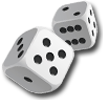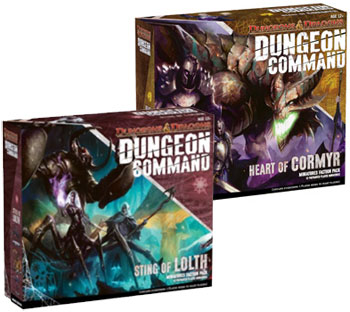



play board games
Board game reviews, strategy tips & session reports
Dungeon Command Review
 Stats:
Stats:
No. of players: 2 (up to four with variant rules)
Amount of time to play: 90 min
Age requirements: 12+
Set-up time: 5 – 10 minutes
Dungeon Command Rules Description:
Dungeon Command is a card-driven miniatures skirmish game. Set in the world of Dungeons and Dragons, two factions have been released: the Drow and the Heroes of Cormyr.
You start Dungeon Command by building the map. You and your opponent decide if you are fighting indoors or outside. Then you build your side of the map (with the included four tiles) and connect it to your opponent’s side.
Next you pick your Commander. This character is not on the map, but it represents you. Each Commander has different stats and a different special ability they give their troops. Their stats determine your number of starting order cards and creature hand size. The other two stats on the Commander Card are Morale and Leadership. When you are out of Morale you lose and Leadership is the total level of creatures you may have on the map.
Creature Cards contain each figure’s stats and abilities. These cards are drawn randomly and may only be deployed if your Commander’s Leadership is high enough to get them on the field. Some creatures have a ranged attack and all have a melee attack and a level. When they are eliminated you lose Morale equal to their level.
Order cards allow you to do extra damage, make special attacks and even avoid damage altogether. To use an Order Card your creature must have a level equal to or greater than the Order Card’s level and share an ability listed on the card. If your creature is too low level, it can be assisted by another adjacent creature. Some Order Cards are played in response to your opponent’s actions on their turn.
To start your turn you draw one Order Card and untap all your creatures. Then you can activate all of your creatures, one at a time. Each creature can move once, attack or play order cards. Once a creature attacks it is tapped and though it may still move after attacking it cannot take another standard action. Some Order Cards are minor actions which are unlimited each turn.
Movement rate differs based on the creature, but once you become adjacent to an enemy figure you must stop. If you start your movement adjacent to another creature your speed is one.
After you use all your creatures you gain one point of Leadership and may Deploy new creatures. You still cannot have more levels of Creatures on the map than you have Leadership. Lastly your creatures untap and it is your opponent’s turn.
You can avoid ranged damage if your opponent does not have a clear line of sight to your creature. This taps your creature, so you can only avoid one ranged attack per turn. The other way to avoid damage is to Cower. If you cower you avoid all damage from an attack, but must lose Morale equal to the damage that would have been inflicted divided by ten.
You can gain Morale by finding and collecting treasure. A treasure chest contains one to three treasure tokens and each token adds one to your total Morale. It takes a standard action to open the chest and one for each token you collect.
The player that either runs out of Morale or has no creatures on the board loses.
Quick Review of Dungeon Command:
Dungeon Command is a great skirmish game that has fun mechanics and a strong theme. Both the Heart of Cormyr and Sting of Lolth factions are unique and have different strategic strengths. The rules are easy to read and follow, the figures look excellent and all the chits and cards are top-notch.
I like a lot of things about this game. First there are no dice. Now don’t get me wrong, I like dice and don’t mind a bit of randomness in my games, but it is nice to play a skirmish game without them. The Order and Creature Cards do add randomness, but you’ll always be able to attack even if you don’t have any useful Order Cards.
There are also some tough but strategic decisions around Cowering. Do you lose Morale so a figure can live to retaliate? Will losing Morale from Cowering make you lose the game if your opponent can eliminate your level four creature? Is it worth the risk?
The different Commanders add replay value and effect the way each faction plays. There is also nice synergy in your Leadership the levels and number of creatures you have on the board. You might destroy you opponent’s creature just so they can Deploy a bigger threat.
I would suggest getting both the Heart of Cormyr and Sting of Lolth sets. You can play with just one of the factions but the game play and map layout suffers a bit. There is definitely more depth with both sets.
There are also rules for creating your own warbands and three or four player games. You can get as involved as you like. If you are looking to play in tournaments you will probably buy multiple sets of each faction.
Another excellent perk is that each figure comes with card to use in the Dungeons and Dragons Adventure Board Games. So if you own Castle Ravenloft, Wrath of Ashardalon or The Legend of Drizzt you get double duty from these miniatures.
If you enjoy skirmish games, fantasy settings or are looking for a fun 2 player game, you should try Dungeon Command. You will not be disappointed, I wasn’t.
Score and synopsis: (Click here for an explanation of these review categories.)
Strategy 5 out of 6
Luck 4 out of 6
Player Interaction 6 out of 6
Replay Value 5 out of 6
Complexity 4 out of 6
Fun 6 out of 6
Overall 6 out of 6

12 Prepainted plastic miniatures just for 27$? Just because of that I would buy this sets.
The cards and anything else is a nice addition.